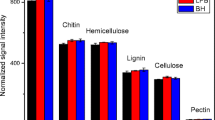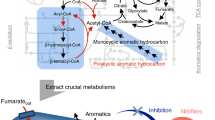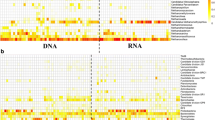Abstract
The microbial ecosystems of the sludge were characterized in terms of the core community structure, functional pathways, and functional redundancy through Illumina MiSeq sequencing and PICRUSt analysis on the activated sludge (AS) samples from an extended activated aeration process. Based on the identified OTU distribution, we identified 125 core community genera, including 3 abundant core genera and 21 intermittent abundant core genera. Putative genera Nitrosomonas, Nitrotoga, Zoogloea, Novosphingobium, Thermomonas, Amaricoccus, Tetrasphaera, Candidatus Microthrix, and Haliscomenobacter, which are associated with functions of nitrifying, denitrifying, phosphorus accumulating, and bulking and foaming, were found to present as the core community organisms in the AS sampled from the conventional extended aeration AS processes. The high-abundant nitrogen metabolic pathways were associated with nitrate reduction to ammonium (DNRA and ANRA), denitrification, and nitrogen fixation, while the ammonia oxidation–related genes (amo) were rarely annotated in the AS samples. Strict functional redundancy was not found with the AS ecosystem as it showed a high correlation between the community composition similarity and function similarity. In addition, the classified dominant core genera community was found to be sufficient to characterize the functionality of AS, which could invigorate applications of 16S rDNA MiSeq sequencing and PICRUSt for the prediction of functions of AS ecosystems.






Similar content being viewed by others
References
Modin O, Persson F, Wilén B-M, Hermansson M (2016) Nonoxidative removal of organics in the activated sludge process. Crit Rev Environ Sci Technol 46:635–672. https://doi.org/10.1080/10643389.2016.1149903
Liu Y, Zhang T, Fang HHP (2005) Microbial community analysis and performance of a phosphate-removing activated sludge. Bioresour Technol 96:1205–1214. https://doi.org/10.1016/j.biortech.2004.11.003
Yao Q, Peng D-C (2017) Nitrite oxidizing bacteria (NOB) dominating in nitrifying community in full-scale biological nutrient removal wastewater treatment plants. AMB Express 7:25–35. https://doi.org/10.1186/s13568-017-0328-y
Xia S, Duan L, Song Y et al (2010) Bacterial community structure in geographically distributed biological wastewater treatment reactors. Environ Sci Technol 44:7391–7396. https://doi.org/10.1021/es101554m
An Y, Zhou Z, Yao J, Niu T, Qiu Z, Ruan D, Wei H (2017) Sludge reduction and microbial community structure in an anaerobic/anoxic/oxic process coupled with potassium ferrate disintegration. Bioresour Technol 245:954–961. https://doi.org/10.1016/J.BIORTECH.2017.09.023
Pervin HM, Dennis PG, Lim HJ et al (2013) Drivers of microbial community composition in mesophilic and thermophilic temperature-phased anaerobic digestion pre-treatment reactors. Water Res 47:7098–7108. https://doi.org/10.1016/J.WATRES.2013.07.053
Zhang T, Shao M-F, Ye L (2012) 454 pyrosequencing reveals bacterial diversity of activated sludge from 14 sewage treatment plants. ISME J 6:1137–1147. https://doi.org/10.1038/ismej.2011.188
Chen H, Chang S (2017) Impact of temperatures on microbial community structures of sewage sludge biological hydrolysis. Bioresour Technol 245:502–510. https://doi.org/10.1016/J.BIORTECH.2017.08.143
Ju F, Guo F, Ye L et al (2014) Metagenomic analysis on seasonal microbial variations of activated sludge from a full-scale wastewater treatment plant over 4 years. Environ Microbiol Rep 6:80–89. https://doi.org/10.1111/1758-2229.12110
Zhang H, Feng J, Chen S, Zhao Z, Li B, Wang Y, Jia J, Li S, Wang Y, Yan M, Lu K, Hao H (2019) Geographical patterns of nirS gene abundance and nirS-type denitrifying bacterial community associated with activated sludge from different wastewater treatment plants. Microb Ecol 77:304–316. https://doi.org/10.1007/s00248-018-1236-7
Saunders AM, Albertsen M, Vollertsen J, Nielsen PH (2016) The activated sludge ecosystem contains a core community of abundant organisms. ISME J 10:11–20. https://doi.org/10.1038/ismej.2015.117
Liu F, Hu X, Zhao X et al (2019) Microbial community structures’ response to seasonal variation in a full-scale municipal wastewater treatment plant. Environ Eng Sci 36:172–179. https://doi.org/10.1089/ees.2018.0280
Gao Y, Peng Y, Zhang J, Wang S, Guo J, Ye L (2011) Biological sludge reduction and enhanced nutrient removal in a pilot-scale system with 2-step sludge alkaline fermentation and A2O process. Bioresour Technol 102:4091–4097. https://doi.org/10.1016/j.biortech.2010.12.051
Guo J, Ni B-J, Han X, Chen X, Bond P, Peng Y, Yuan Z (2017) Unraveling microbial structure and diversity of activated sludge in a full-scale simultaneous nitrogen and phosphorus removal plant using metagenomic sequencing. Enzym Microb Technol 102:16–25. https://doi.org/10.1016/J.ENZMICTEC.2017.03.009
Yu K, Zhang T (2012) Metagenomic and Metatranscriptomic analysis of microbial community structure and gene expression of activated sludge. PLoS One 7:e38183. https://doi.org/10.1371/journal.pone.0038183
Langille MGI, Zaneveld J, Caporaso JG, McDonald D, Knights D, Reyes JA, Clemente JC, Burkepile DE, Vega Thurber RL, Knight R, Beiko RG, Huttenhower C (2013) Predictive functional profiling of microbial communities using 16S rRNA marker gene sequences. Nat Biotechnol 31:814–821. https://doi.org/10.1038/nbt.2676
Lin X, Hetharua B, Lin L, Xu H, Zheng T, He Z, Tian Y (2019) Mangrove sediment microbiome: adaptive microbial assemblages and their routed biogeochemical processes in Yunxiao Mangrove National Nature Reserve, China. Microb Ecol 78:57–69. https://doi.org/10.1007/s00248-018-1261-6
Baker GC, Smith JJ, Cowan DA (2003) Review and re-analysis of domain-specific 16S primers. J Microbiol Methods 55:541–555. https://doi.org/10.1016/j.mimet.2003.08.009
Wang Y, Qian P-Y (2009) Conservative fragments in bacterial 16S rRNA genes and primer design for 16S ribosomal DNA amplicons in metagenomic studies. PLoS One 4:e7401. https://doi.org/10.1371/journal.pone.0007401
Liu Z, DeSantis TZ, Andersen GL, Knight R (2008) Accurate taxonomy assignments from 16S rRNA sequences produced by highly parallel pyrosequencers. Nucleic Acids Res 36:120–130. https://doi.org/10.1093/nar/gkn491
Schloss PD, Westcott SL, Ryabin T, Hall JR, Hartmann M, Hollister EB, Lesniewski RA, Oakley BB, Parks DH, Robinson CJ, Sahl JW, Stres B, Thallinger GG, van Horn D, Weber CF (2009) Introducing mothur: open-source, platform-independent, community-supported software for describing and comparing microbial communities. Appl Environ Microbiol 75:7537–7541. https://doi.org/10.1128/AEM.01541-09
Edgar RC (2013) UPARSE: highly accurate OTU sequences from microbial amplicon reads. Nat Methods 10:996–998. https://doi.org/10.1038/nmeth.2604
Edgar RC, Haas BJ, Clemente JC, Quince C, Knight R (2011) UCHIME improves sensitivity and speed of chimera detection. Bioinformatics 27:2194–2200. https://doi.org/10.1093/bioinformatics/btr381
Schloss PD, Gevers D, Westcott SL (2011) Reducing the effects of PCR amplification and sequencing artifacts on 16S rRNA-based studies. PLoS One 6:e27310. https://doi.org/10.1371/journal.pone.0027310
Edgar RC (2010) Search and clustering orders of magnitude faster than BLAST. Bioinformatics 26:2460–2461. https://doi.org/10.1093/bioinformatics/btq461
Yadav TC, Khardenavis AA, Kapley A (2014) Shifts in microbial community in response to dissolved oxygen levels in activated sludge. Bioresour Technol 165:257–264. https://doi.org/10.1016/j.biortech.2014.03.007
Stoddard SF, Smith BJ, Hein R, Roller BR, Schmidt TM (2015) rrnDB: improved tools for interpreting rRNA gene abundance in bacteria and archaea and a new foundation for future development. Nucleic Acids Res 43:593–598. https://doi.org/10.1093/nar/gku1201
Sampson TR, Debelius JW, Thron T et al (2016) Gut microbiota regulate motor deficits and Neuroinflammation in a model of Parkinson’s disease. Cell 167:1469–1480.e12. https://doi.org/10.1016/J.CELL.2016.11.018
Parks DH, Tyson GW, Hugenholtz P, Beiko RG (2014) STAMP: statistical analysis of taxonomic and functional profiles. Bioinformatics 30:3123–3124. https://doi.org/10.1093/bioinformatics/btu494
Gibson DJ, Ely JS, Collins SL (1999) The core-satellite species hypothesis provides a theoretical basis for Grime’s classification of dominant, subordinate, and transient species. J Ecol 87:1064–1067. https://doi.org/10.1046/j.1365-2745.1999.00424.x
Gao P, Xu W, Sontag P, Li X, Xue G, Liu T, Sun W (2016) Correlating microbial community compositions with environmental factors in activated sludge from four full-scale municipal wastewater treatment plants in Shanghai, China. Appl Microbiol Biotechnol 100:4663–4673. https://doi.org/10.1007/s00253-016-7307-0
Metcalf, Eddy (2014) Wastewater engineering: treatment and resource recoveryfifth edn. McGraw-Hill Education, New York
Geets J, Boon N, Verstraete W (2006) Strategies of aerobic ammonia-oxidizing bacteria for coping with nutrient and oxygen fluctuations. FEMS Microbiol Ecol 58:1–13. https://doi.org/10.1111/j.1574-6941.2006.00170.x
Daims H, Lebedeva EV, Pjevac P, Han P, Herbold C, Albertsen M, Jehmlich N, Palatinszky M, Vierheilig J, Bulaev A, Kirkegaard RH, von Bergen M, Rattei T, Bendinger B, Nielsen PH, Wagner M (2015) Complete nitrification by Nitrospira bacteria. Nature 528:504–509. https://doi.org/10.1038/nature16461
Alawi M, Off S, Kaya M, Spieck E (2009) Temperature influences the population structure of nitrite-oxidizing bacteria in activated sludge. Environ Microbiol Rep 1:184–190. https://doi.org/10.1111/j.1758-2229.2009.00029.x
Nielsen PH, Mielczarek AT, Kragelund C, Nielsen JL, Saunders AM, Kong Y, Hansen AA, Vollertsen J (2010) A conceptual ecosystem model of microbial communities in enhanced biological phosphorus removal plants. Water Res 44:5070–5088. https://doi.org/10.1016/J.WATRES.2010.07.036
Zielińska M, Rusanowska P, Jarząbek J, Nielsen JL (2016) Community dynamics of denitrifying bacteria in full-scale wastewater treatment plants. Environ Technol 37:2358–2367. https://doi.org/10.1080/09593330.2016.1150350
Cheng C, Zhou Z, Pang H, Zheng Y, Chen L, Jiang LM, Zhao X (2018) Correlation of microbial community structure with pollutants removal, sludge reduction and sludge characteristics in micro-aerobic side-stream reactor coupled membrane bioreactors under different hydraulic retention times. Bioresour Technol 260:177–185. https://doi.org/10.1016/J.BIORTECH.2018.03.088
Mergaert J, Cnockaert MC, Swings J (2003) Thermomonas fusca sp. nov. and Thermomonas brevis sp. nov., two mesophilic species isolated from a denitrification reactor with poly( −caprolactone) plastic granules as fixed bed, and emended description of the genus Thermomonas. Int J Syst Evol Microbiol 53:1961–1966. https://doi.org/10.1099/ijs.0.02684-0
Zhang L, Sun H, Zhang X, Ren H, Ye L (2018) High diversity of potential nitrate-reducing Fe (II)-oxidizing bacteria enriched from activated sludge. Appl Microbiol Biotechnol 102:4975–4985. https://doi.org/10.1007/s00253-018-8961-1
Straub KL, Schönhuber WA, Buchholz-Cleven BEE, Schink B (2004) Diversity of ferrous Iron-oxidizing, nitrate-reducing Bacteria and their involvement in oxygen-independent Iron cycling. Geomicrobiol J 21:371–378. https://doi.org/10.1080/01490450490485854
Strand SE, McDonnell AJ, Unz RF (1988) Oxygen and nitrate reduction kinetics of a nonflocculating strain of Zoogloea ramigera. Antonie Van Leeuwenhoek 54:245–255. https://doi.org/10.1007/BF00443583
Huang T-L, Zhou S-L, Zhang H-H, Bai SY, He XX, Yang X (2015) Nitrogen removal characteristics of a newly isolated indigenous aerobic denitrifier from oligotrophic drinking water reservoir, Zoogloea sp. N299. Int J Mol Sci 16:10038–10060. https://doi.org/10.3390/ijms160510038
Xia Y, Wen X, Zhang B, Yang Y (2018) Diversity and assembly patterns of activated sludge microbial communities: a review. Biotechnol Adv 36:1038–1047. https://doi.org/10.1016/J.BIOTECHADV.2018.03.005
Muszyński A, Załęska-Radziwiłł M (2015) Polyphosphate accumulating organisms in treatment plants with different wastewater composition. Architect Civ Eng Environ:99–106
Mielczarek AT, Nguyen HTT, Nielsen JL, Nielsen PH (2013) Population dynamics of bacteria involved in enhanced biological phosphorus removal in Danish wastewater treatment plants. Water Res 47:1529–1544. https://doi.org/10.1016/J.WATRES.2012.12.003
Marrengane Z, Kumar SKS, Pillay L, Bux F (2011) Rapid quantification and analysis of genetic diversity among Gordonia populations in foaming activated sludge plants. J Basic Microbiol 51:415–423. https://doi.org/10.1002/jobm.201000213
Kaetzke A, Jentzsch D, Eschrich K (2005) Quantification of Microthrix parvicella in activated sludge bacterial communities by real-time PCR. Lett Appl Microbiol 40:207–211. https://doi.org/10.1111/j.1472-765X.2005.01656.x
Kotay SM, Datta T, Choi J, Goel R (2011) Biocontrol of biomass bulking caused by Haliscomenobacter hydrossis using a newly isolated lytic bacteriophage. Water Res 45:694–704. https://doi.org/10.1016/J.WATRES.2010.08.038
Louca S, Polz MF, Mazel F, Albright MBN, Huber JA, O'Connor MI, Ackermann M, Hahn AS, Srivastava DS, Crowe SA, Doebeli M, Parfrey LW (2018) Function and functional redundancy in microbial systems. Nat Ecol Evol 2:936–943. https://doi.org/10.1038/s41559-018-0519-1
Fan X-Y, Gao J-F, Pan K-L et al (2017) Temporal dynamics of bacterial communities and predicted nitrogen metabolism genes in a full-scale wastewater treatment plant. RSC Adv 7:56317–56327. https://doi.org/10.1039/C7RA10704H
Fuhrman JA, Cram JA, Needham DM (2015) Marine microbial community dynamics and their ecological interpretation. Nat Rev Microbiol 13:133–146. https://doi.org/10.1038/nrmicro3417
Sunagawa S, Coelho LP, Chaffron S et al (2015) Ocean plankton. Structure and function of the global ocean microbiome. Science 348:1261359. https://doi.org/10.1126/science.1261359
Louca S, Parfrey LW, Doebeli M (2016) Decoupling function and taxonomy in the global ocean microbiome. Science 353:1272–1277. https://doi.org/10.1126/science.aaf4507
Vanwonterghem I, Jensen PD, Rabaey K, Tyson GW (2016) Genome-centric resolution of microbial diversity, metabolism and interactions in anaerobic digestion. Environ Microbiol 18:3144–3158. https://doi.org/10.1111/1462-2920.13382
Wang X, Wen X, Yan H et al (2011) Bacterial community dynamics in a functionally stable pilot-scale wastewater treatment plant. Bioresour Technol 102:2352–2357. https://doi.org/10.1016/J.BIORTECH.2010.10.095
Wells GF, Park H-D, Yeung C-H et al (2009) Ammonia-oxidizing communities in a highly aerated full-scale activated sludge bioreactor: betaproteobacterial dynamics and low relative abundance of Crenarchaea. Environ Microbiol 11:2310–2328. https://doi.org/10.1111/j.1462-2920.2009.01958.x
Galand PE, Pereira O, Hochart C, Auguet JC, Debroas D (2018) A strong link between marine microbial community composition and function challenges the idea of functional redundancy. ISME J 12:2470–2478. https://doi.org/10.1038/s41396-018-0158-1
Acknowledgments
The authors thanks the Ministry of Economic Development, Job Creation and Trade for the support of Ontario Research Fund-Research Excellence (ORF-RE), and the Guelph Wastewater Treatment Plant for providing samples and processing information.
Author information
Authors and Affiliations
Corresponding author
Ethics declarations
Conflict of Interest
The authors declare that they have no conflict of interest.
Electronic supplementary material
ESM 1
(DOCX 718 kb)
Rights and permissions
About this article
Cite this article
Chen, H., Wang, M. & Chang, S. Disentangling Community Structure of Ecological System in Activated Sludge: Core Communities, Functionality, and Functional Redundancy. Microb Ecol 80, 296–308 (2020). https://doi.org/10.1007/s00248-020-01492-y
Received:
Accepted:
Published:
Issue Date:
DOI: https://doi.org/10.1007/s00248-020-01492-y




